Cover Snaps for a Touch of Couture
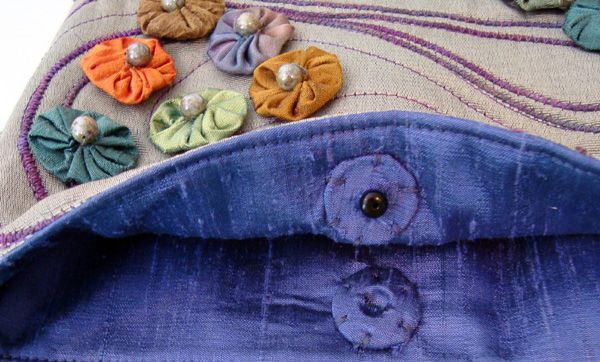
The word “couture” can imply the garment is difficult and time-consuming. But it really stands for quality workmanship. Often, couture techniques are easy to do. A good example is the covered snap. In just an extra minute or two, you can add this elegant touch to a garment or accessory that requires a large snap closure.
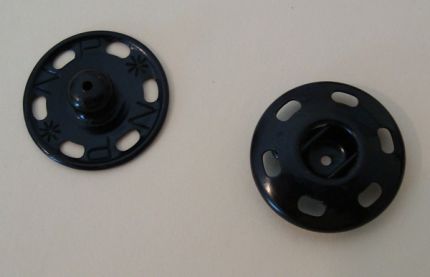
Cover the snap, ball side
1. Cut a circle of lightweight fabric about twice the diameter of the snap. Sew a row of running stitches near the edge of the circle.
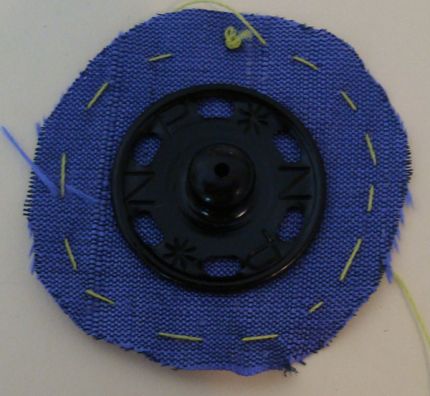
2. Work a small hole in the center of the snap and push the ball through it.
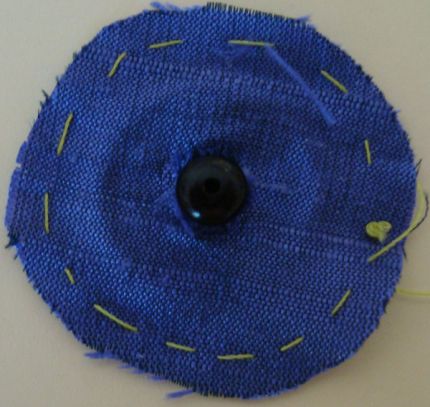
3. Pull up the thread to cover the snap and secure it in place to your garment.
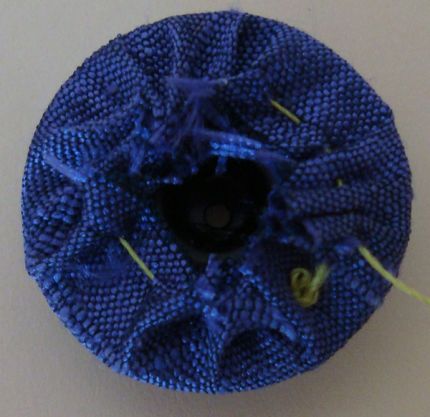
Cover the snap, socket side
Work the socket section of the snap in the same way. Snapping the sections together will push the fabric into the hole on this section.
Go ahead and try this method to cover snaps.
Start your 14-day FREE trial to access this story.
Start your FREE trial today and get instant access to this article plus access to all Threads Insider content.
Start Your Free TrialAlready an Insider? Log in




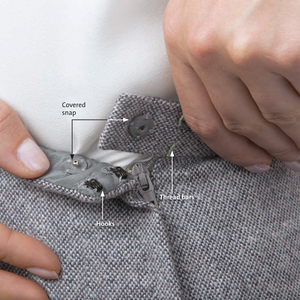
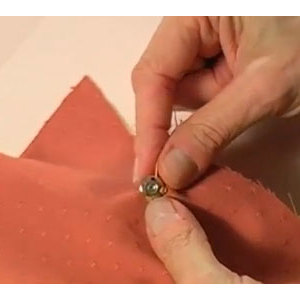
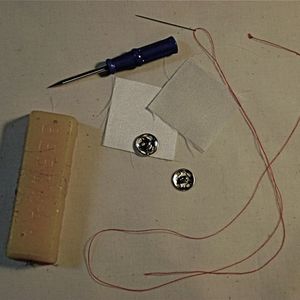



























I'm really having a problem understanding why a couture column would advocate 'cutting' a spot open for the snap...
This is a guaranteed weak spot (quickly fraying out) and it will positively scream Home-made!
I've used this technique successfully many times with many weights of fabric; an awl will gently spread the threads apart to push the ball through and on the female side, very short sts around the circle will hold the warp and weft threads back out of the way.
Please don't talk down to us and take the easy, kindergarten way out.
We look to Threads for short cuts, but also for QUALITY!
I agree with rkr4cds1. Threads is where I look to find out the right way to do these little couture touches that contribute to a quality garment. I want to know the best way not the easiest way, unless that is also acceptable. Sometimes it is good to know more than one way to do a procedure, but I do want to know the more professional way along with the easy way.
Hi Mary - Tks for that. I agree with rkr4cds1 -re using an awl to gently push the threads apart-rather than'cutting' as that would produce a 'weak spot'.
I was also initially puzzled by the Americanised language - & had to investigate 'snaps'- which we call press studs!!
I didn't mean to cause a fuss. Your comments about expecting the best from Threads are appreciated and well taken, as are your comments about using an awl -- which, for many fabrics and snaps is the best alternative and I should have said that. However, the fabric I used in my example is a very tightly woven dupioni, which the awl penetrates to spread the threads but does not leave a large enough opening to insert the ball of this very large snap. So the tiny cut in this case stays pretty much within its territory and even with numerous "snappings" has not increased the size of the hole.(The photos, by the way, are of high resolution so the yarns of the fabric look enormous!)
Thank you all for paying attention, keeping me on track, and most of all for being such loyal Threads readers and fans.
I love my Threads mag. for all the wonderful professional in
formation in it.
I am sure there are times that someone doesn't agree with the way something is done, but please be polite in the way that you submit your comment!
As I began this Comments section, I'd like to clarify something, though my statements certainly are stand-alone ones and ones which MaryRay and others appear to have understood.
They were made with respect as I would to any other professional; as I treat all individuals respectfully and appreciatively because we all have different points of view depending on our background and/or experience.
What I was referring to was the appearance of the loose threads laying alongside the snap's ball in image #2.
The easily-frayed cut edges of this particular material is in evidence in the last image as well, which lead me to think that a spreading of the warp and weft would serve the purpose better than cutting them.
Or, alternatively, if cutting is a must, then to suggest overcasting the cut edges with a fine thread, as I would worry about future unraveling at that spot in a garment that I was to wear, at the same time elevating it into the realm of Hand-Made rather than Home-Made.
To me, anything that can be done as a preventative rather than as a later 'fix', is far better. Once threads begin to fray out of a close-set area like this it's almost impossible to put them back into their original positions.
My comments were directed toward - - '...an ounce of Prevention..."
It's perhaps a mountain out of a molehill, but isn't it "all in the details"?
And I am somewhat tongue-in-cheek, as I take all sewing and needlework seriously but don't wish to upset anyone here by posting.
Please forgive me if this is toe-stepping!!!
In fact, I'm even more convinced of the direction of my comments when I view the very first sentences in this article:
[Sometimes the word “couture” implies difficult and time consuming.
But it really stands for quality workmanship..."]
This column is definitely not for Sewing 101.
We can get that on too many other sites.
I expect Threads to offer us TOP QUALITY Couture, for today's busy woman.
I was a subscriber from the very first issue in the 80s when I was a working woman.
Now that I have changed professions and am a Fiber Artist/Sole Proprietor of my own business, I value individual, hand's on QUALITY work even more.
an awl would not have made a large enough hole this is true. however... an old fashoned bone stelleto would. they come in varing sizes.. and they make a hole large enough to make eyelets for lacing ball gowns. the beauty of it is that you seperate the threads and do not break or cut them. the integrety of the fabric remains. I have make considerable holes that a snap head would fit through..
Why couldn't you use fray check on this?
I certainly glad to have found your article on covered snaps. I always find a better clouser than snaps because of the raw apperance of the snap. I will certainly try your
idea and sure it will work. I have been sewing since the age of 7 years mostly on my own. My mother encouraged me
but was legally blind and unable to help. It is articles
like yours that continues to teach me and other that want
to try something new..
it appears that after sewing the last 60 years that there are usually 2 or 3 ways a project can been done. It is wonderful to be able to access these techniques in a forem such as this. It would appear that there are some who have very thin skin. In something like this you may have an easier better way of doing something or a safer way, then utilize it and share it but don't talk down to the contributor or the person logging their comment.
Oh I have not sewn in years and this makes me want to pick it up again. Nowadays, I am a felter/fiber artist and employ my sewing skill into my artwork. In fact, I have some uses for this covered snaps.
Thank you,
Debra
Interesting to see this method shown as a couture technique. My grandmother was doing this on my mother's clothes in the 40's and 50's. They have stood the test of time and her great, great, great granddaughters are still wearing and treasuring some of these garments today.
I think this is a great idea. May I suggest that you could attach iron-on interfacing to the fabric, which would make it easier to handle, and reduce the chances of the fabric fraying. (This is also useful when making covered buttons.)
I have been sewing since I was 7 and am now retired, but still love to be sewing more than any other hobby.
HI I love all the wonderful tips that the experts and other sewers give, But OH!OH! I shudder at the sexual content of your esteemed website. I am talking about THE TERMS MALE AND FEMALE!.
Excuuuuuuse meeeee.Who would fail to see the pornigraphic conotations of the piece with a ball, and the other piece coyly called the female piece, with one fitting in to the other. I am shocked! Please put a warning at the top of the page regarding sexual content!
Seriously though, aren't these terms a little sexist and outdated? How about the 'prong bit fited into the prong case? Oh I don't know. It's the same thing when you talk to an electrician or a mechanic. what devious mind started this in the first place. (By the way I say all this tongue in cheek) I love your magazine.
I have tried this technique with fabrics that the awl was not adequate for creating the hole I needed. I found that the small hole punch from my scrapbooking tools worked wonderfully. I then applied fray check to the 'hole' after getting the fabric sewn onto the snap. I have worn and washed the garment several times, and absolutely no fraying.
Just because something isn't done the difficult way does not mean it was done with any less quality. I love the quality of techniques I have learned from Threads. Some people need to just get over themselves and enjoy sewing. Thanks for all the great ideas and skills I have learned from your magazine!
The person who chastised the writer of the article and the website for allowing "pornographic content" needs to be made aware that his/her comments display a simple ignorance of the fact that it is entirely acceptable usage, particularly when speaking of constructing things, to refer to male and female parts of an apparatus. There is absolutely nothing dirty, obscene, or inappropriate about doing so in that context. And the poster owes the website and the writer an apology.
iceni....you are either very young or extremely naive....The terminology used in this article has been around forever. You'd best not go to any hardware store looking for fittings of any sort as that is the only terminology used there for a lot of stuff.
Thank you MaryRay for this contribution...this is one of the many reasons I look to Threads as well, and have for many yrs.
iceni - FYI -The same terminology is used in Many other languages, it refers to a pair of hardware that fit perfectly together, and in this article it only refer to the snaps and nothing more. I could never think of someone will interpret this as sexual content in a million years. Didn't we learn this term in school during sewing or construction classes? I think you owe the website and the writer an apology.
She said it tongue in cheek people...
as for the hole in question.. a stiletto will work a big enough hole and not require any additional work, fuss or expense..
Mary Ray, This is wonderful, thank you "sew" much for posting it.. I began sewing on my grandmother's treadle machine around 5 years old (she taught me to sew doll clothes). And for several years my Mother held sewing classes for underprivileged mothers' in the 70's and I attended some of the classes. As my skills progressed I began to sew in a few couture shops and this is exactly the way that various snaps are covered.
As to the reference to the male and female components, This is the only way I have ever heard them referred to. If they were referred to in another way, no one would know what you were talking about.
Mary Ray, This is wonderful, thank you "sew" much for posting it.. I began sewing on my grandmother's treadle machine around 5 years old (she taught me to sew doll clothes). And for several years my Mother held sewing classes for underprivileged mothers' in the 70's and I attended some of the classes. As my skills progressed I began to sew in a few couture shops and this is exactly the way that various snaps are covered.
As to the reference to the male and female components, This is the only way I have ever heard them referred to. If they were referred to in another way, no one would know what you were talking about.
Lovely how-to and gorgeous photographs. Thank you Mary and all the other professionals who take the time to put together these sewing and fitting tips.
BTW historically the use of the terms male and female is, and has been standard to describe any type of electric, audio, electronic, computer or manual connector, plug, snap etc. There are no "politically correct" replacement terms. In this day and age, it's hard to believe that anyone could be unaware of this.
Thanks "sew" much for the interesting technique. Would this also work for larger buttons? I know you can buy buttons that are specially made to be covered but I have never had much luck with them. This seems to be an easier solution - if it will work.
And to those critical of the person who made the comments regarding terminology - did you not catch her "I say this tongue in cheek" comment? While it was an attempt at levity which failed - make sure you read all the way through!
I have read about this technique before in some of my internet ramblings, and used it, and it's lovely. On an additional related subject. Those little handmade silk rosettes with the pearl center are a lovely added detail. Makes me want to see a photo of whole item. (is it a handbag?) Looks like some decorative couching, too? Beautiful!